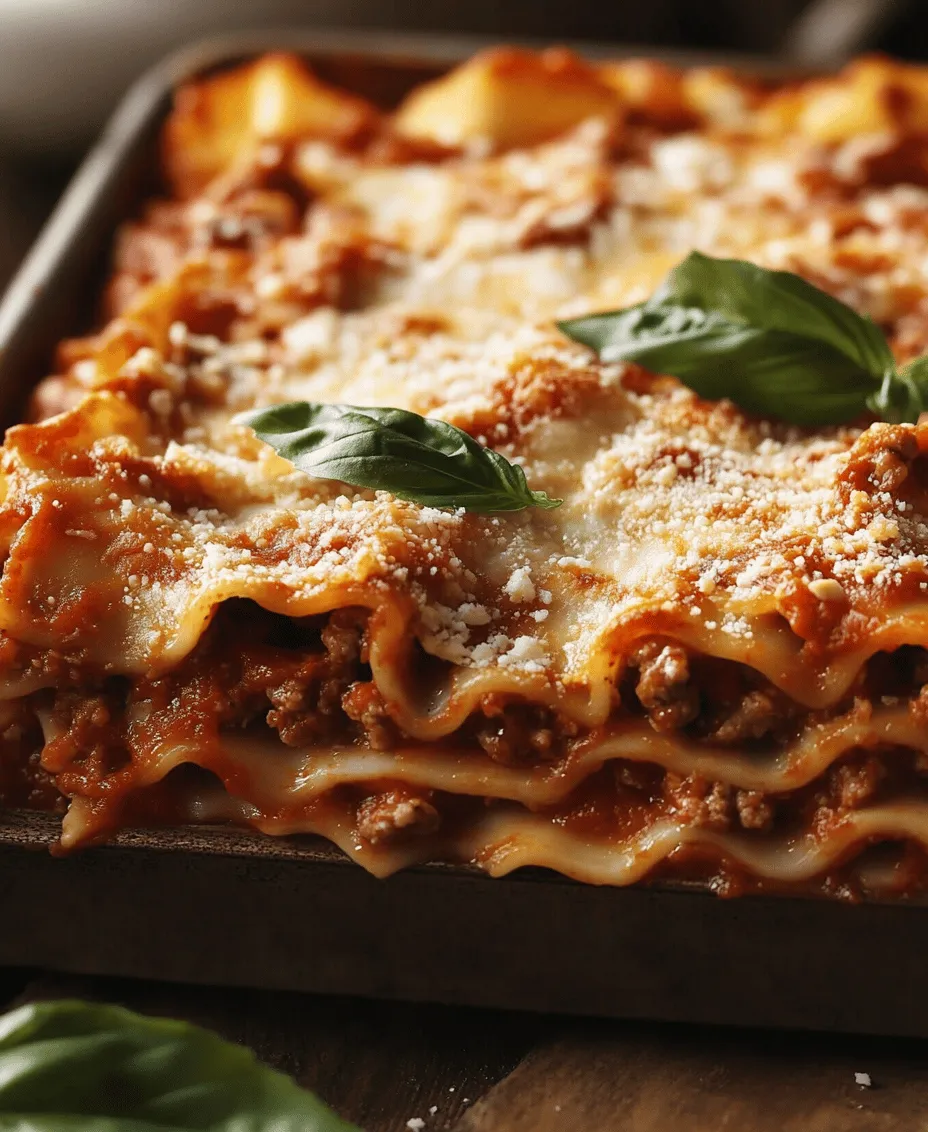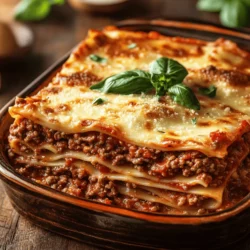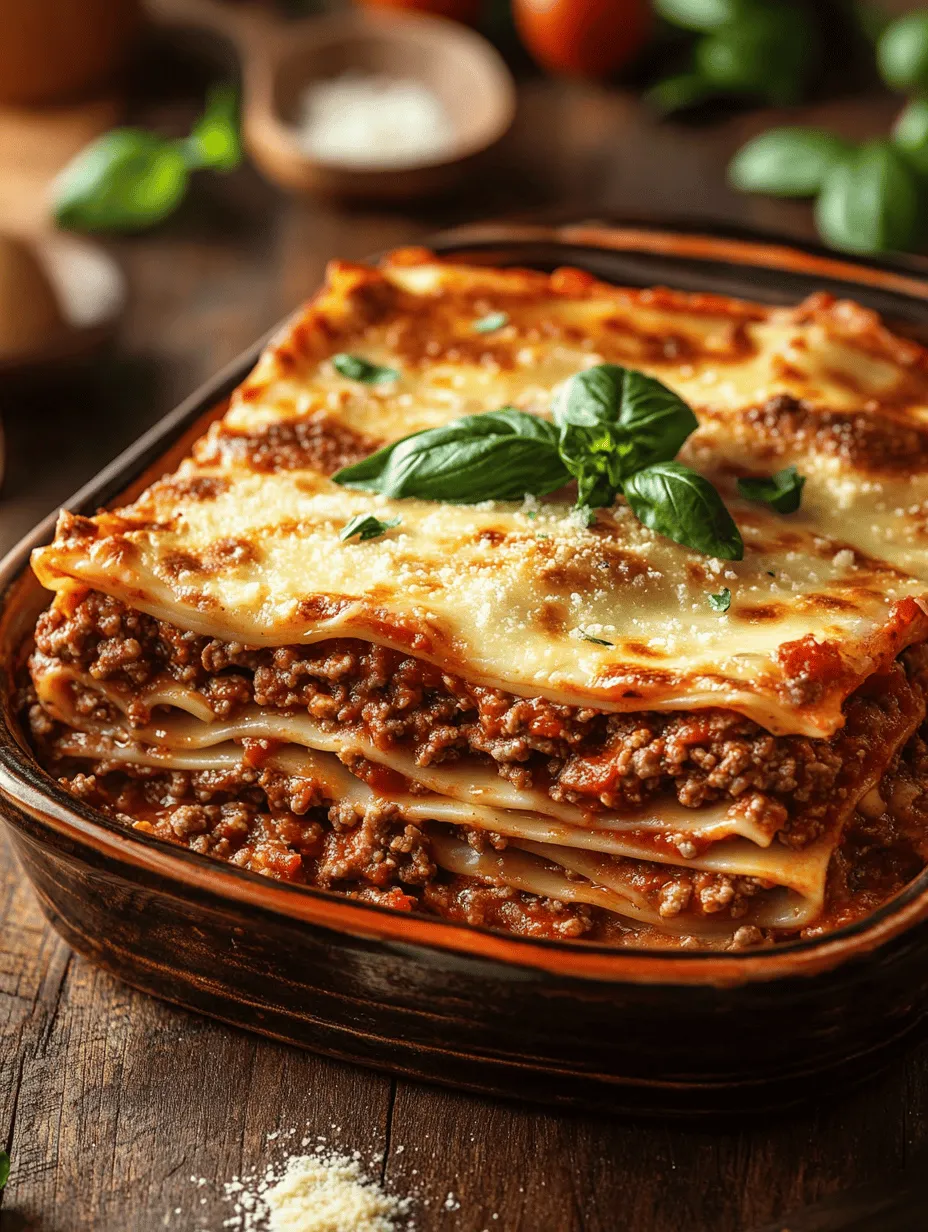Lasagna, a staple of Italian cuisine, is much more than just a dish; it’s a comforting experience that brings family and friends together. This layered pasta masterpiece has captured the hearts of food lovers across the globe, invoking memories of family gatherings, festive occasions, and hearty meals shared around the dinner table. Each bite of lasagna offers a delightful interplay of flavors and textures, from the rich, savory meat sauce to the creamy layers of cheese and delicate pasta. In this article, we delve into the art of making Classic Lasagna Delight and provide you with everything you need to know to create this beloved dish from scratch.
Homemade lasagna holds a special place in many households, often reserved for celebrations or cozy Sundays. There’s something incredibly satisfying about crafting this dish yourself; it allows you to control the quality of ingredients and to customize flavors to suit your preferences. Whether you’re planning a family gathering, a cozy dinner with friends, or simply want to treat yourself to a delicious meal, this lasagna recipe will not disappoint. Throughout this article, you can expect a comprehensive guide that includes not only the classic recipe but also tips for perfecting your lasagna, insights into its rich history, and serving suggestions that will impress your guests.
The Rich History of Lasagna
Lasagna’s origins can be traced back to Ancient Greece, where a dish called Laganon was made from layers of pasta and sauce. However, it wasn’t until the dish made its way to Italy that it transformed into the lasagna we know and love today. The first documented recipe for lasagna appeared in the 14th century in Naples, which is often credited as the birthplace of modern lasagna. Italian cooks began layering pasta sheets with various fillings, including cheese, meat, and vegetables, which paved the way for many regional variations.
Over the centuries, lasagna has evolved significantly. In the northern regions of Italy, such as Emilia-Romagna, the dish is often made with rich ragù sauces, béchamel, and fresh pasta. In contrast, southern variations might include tomato-based sauces and a variety of cheeses, reflecting the diverse culinary traditions of Italy. Outside of Italy, lasagna has been embraced globally, leading to unique interpretations that incorporate local ingredients and flavors. From vegetarian options to seafood lasagna, the dish has adapted to meet the tastes of different cultures, making it a truly versatile meal.
Ingredients Breakdown
Creating the perfect Classic Lasagna Delight requires an understanding of each ingredient’s role in the dish. Here’s a breakdown of the essential components that come together to create this Italian classic.
Lasagna Noodles
Lasagna noodles are the foundation of the dish. Traditionally, they are made from durum wheat semolina, resulting in a firm texture that holds up well when layered. You can choose between two types of lasagna noodles: oven-ready (no-boil) and regular (boil required). Oven-ready noodles can be layered straight into the dish without pre-cooking, while regular noodles need to be boiled briefly until al dente. If you opt for regular noodles, be sure to follow cooking instructions carefully to prevent them from becoming mushy during baking.
Meat Options
The type of meat used in lasagna can significantly affect its flavor. Ground beef is the traditional choice, offering a rich and robust taste. However, many people prefer ground turkey or chicken for a lighter option. When selecting your meat, consider the fat content; a leaner meat will produce a healthier dish. Browning the meat properly is essential, as it enhances the flavor through caramelization.
Cheese Varieties
Cheese is another crucial element of Classic Lasagna Delight. The combination of ricotta, mozzarella, and Parmesan cheeses creates a creamy and harmonious flavor profile. Ricotta cheese provides a rich, smooth filling, while mozzarella adds stretch and gooeyness when melted. Parmesan, on the other hand, contributes a sharp, nutty flavor that elevates the entire dish. For added depth, consider incorporating a blend of different cheese varieties, such as provolone or fontina.
Herbs and Spices
A well-seasoned lasagna is a delight to the senses. Fresh basil, oregano, and parsley are commonly used herbs that infuse the dish with aromatic flavors. Additionally, garlic and onion enhance the savory notes of the meat sauce. Don’t hesitate to experiment with other herbs and spices, such as thyme or crushed red pepper flakes, to suit your personal taste.
Nutritional Information
Understanding the nutritional content of each ingredient can help you make informed choices. For instance, ground beef typically contains more saturated fat than lean turkey or chicken. Cheese, while delicious, is also high in calories and fat, so balancing your ingredients can lead to a healthier lasagna. Overall, incorporating vegetables like spinach or zucchini can increase the nutritional value and add flavor without compromising the dish’s integrity.
Step-by-Step Cooking Instructions
Now that we’ve covered the ingredients, let’s dive into the step-by-step process of creating Classic Lasagna Delight.
Cooking Lasagna Noodles Perfectly
1. Boil Water: Start by bringing a large pot of salted water to a rolling boil. The salt enhances the flavor of the noodles, so don’t skip this step.
2. Add Noodles: Carefully add the lasagna noodles to the boiling water. If you’re using regular noodles, cook them according to the package instructions, usually around 8-10 minutes, until they are al dente.
3. Drain and Cool: Once cooked, drain the noodles and rinse them under cold water to stop the cooking process. Lay them flat on a clean kitchen towel or parchment paper to prevent sticking.
Preparing a Flavorful Meat Sauce
1. Brown the Meat: In a large skillet, heat olive oil over medium-high heat. Add your chosen ground meat and cook until browned, breaking it apart with a spatula. This step is critical as it develops the flavors that will form the base of your sauce.
2. Sauté Aromatics: Once the meat is browned, add finely chopped onions and minced garlic. Sauté until the onions are translucent, about 3-4 minutes.
3. Simmer with Tomato Sauce: Stir in canned crushed tomatoes, tomato paste, and seasonings (basil, oregano, salt, and pepper). Allow the sauce to simmer on low heat for at least 20 minutes, stirring occasionally. This simmering time allows the flavors to meld beautifully.
Mixing the Ricotta Filling
1. Combine Ingredients: In a mixing bowl, combine ricotta cheese, an egg, grated Parmesan cheese, and a pinch of salt. Mixing in an egg helps bind the filling, ensuring it doesn’t become watery during baking.
2. Adjust Consistency: If the mixture seems too thick, you can add a splash of milk to achieve a smoother consistency. Taste the filling and adjust seasoning as necessary.
3. Add Herbs: For added flavor, fold in fresh chopped herbs such as parsley or basil into the ricotta mixture. This step enhances the overall taste and freshness of your lasagna.
With these foundational steps, you’re well on your way to creating the ultimate Classic Lasagna Delight. The combination of rich flavors, comforting textures, and the joy of creating this dish from scratch make it a beloved recipe in many homes. As you continue with the layering and baking process, the anticipation will build, and soon you’ll have a bubbling, golden lasagna ready to impress your family and friends. Stay tuned for the next segment, where we will cover the layering process, baking instructions, and tips for serving your Classic Lasagna Delight.

Guide to Assembling the Lasagna Layers
As you prepare to assemble your Classic Lasagna Delight, it’s essential to understand the proper layering technique to ensure optimal flavor and texture. The key to a successful lasagna lies in balancing the ingredients and creating distinct layers that meld together beautifully during baking.
Proper Layering Technique for Optimal Flavor and Texture
Begin with a thin layer of marinara sauce at the bottom of your baking dish. This base prevents the noodles from sticking and adds moisture. Follow this with a layer of noodles, ensuring they are evenly spaced and not overlapping excessively. Next, spread a portion of the ricotta mixture over the noodles, followed by a sprinkle of mozzarella cheese. Continue the assembly by adding another layer of sauce, then repeat the process: noodles, ricotta, mozzarella, and sauce. Aim for at least three layers, alternating between the sauce, noodles, and cheese mixture.
For the final layer, top it with a generous amount of marinara sauce and an extra handful of mozzarella cheese. This top layer will create a delightful crust as it bakes, providing a beautiful golden finish.
Visual Cues to Look for During Assembly
As you layer your lasagna, pay attention to the visual cues that indicate you’re on the right track. Look for even coverage of the sauce and cheese, ensuring that no dry patches of noodles remain exposed. The ricotta mixture should be spread smoothly, and the layers should appear harmonious, with each ingredient peeking through the sauce. The final layer should be glossy with sauce and generously topped with cheese, signaling readiness for the oven.
Baking the Lasagna: Timing and Temperature for Perfect Results
Preheat your oven to 375°F (190°C) before placing your lasagna inside. Bake the assembled dish uncovered for about 25 minutes. This initial baking time allows the cheese to melt and the flavors to meld beautifully. After 25 minutes, cover the lasagna with aluminum foil to prevent over-browning and continue baking for an additional 25 to 30 minutes.
You’ll know your lasagna is ready when the cheese is bubbly and golden brown, and a knife inserted into the center comes out hot. Let the dish rest for at least 15 minutes before slicing. This resting period is crucial, as it allows the layers to set, making it easier to serve and enhancing the overall texture.
Serving Suggestions
A classic lasagna is a meal in itself, but it pairs wonderfully with various side dishes that can elevate your dining experience.
Recommendations for Side Dishes that Complement Lasagna
Consider serving a fresh garden salad with a light vinaigrette to balance the richness of the lasagna. The crisp greens and tangy dressing provide a refreshing contrast that complements the hearty pasta. Garlic bread or a crusty Italian bread is another excellent choice, perfect for sopping up any leftover sauce. For a heartier side, you might opt for roasted vegetables, seasoned simply with olive oil, salt, and pepper, which add a nutritious and colorful element to your meal.
Tips for Garnishing the Dish for Presentation
When it comes to garnishing, fresh basil leaves add a pop of color and freshness. Simply sprinkle a few leaves over the top of the lasagna just before serving. You can also consider a dusting of freshly grated Parmesan cheese or a drizzle of high-quality olive oil to enhance the presentation and flavor.
Ideas for Pairing Wine with Lasagna
For wine pairings, a medium-bodied red, such as Chianti or Sangiovese, works beautifully with the flavors of classic lasagna. The acidity of these wines complements the tomato sauce, while their tannins enhance the richness of the cheese and meat. If you prefer white wine, consider a dry Italian Pinot Grigio or a crisp Sauvignon Blanc, which can provide a refreshing contrast.
Storing and Reheating Leftovers
One of the great advantages of lasagna is its ability to be enjoyed even after the initial meal. Here are best practices for storing and reheating your leftovers.
Best Practices for Storing Leftover Lasagna
To store leftover lasagna, allow it to cool completely before transferring it to an airtight container. If you prefer to keep it in the baking dish, cover it tightly with plastic wrap or aluminum foil. Homemade lasagna can be stored in the refrigerator for up to 3-5 days. For longer storage, consider freezing individual portions. Wrap each portion tightly in plastic wrap and then place it in a freezer-safe container or zip-top bag. Frozen lasagna can last up to 3 months.
Tips for Reheating to Maintain Taste and Texture
When reheating lasagna, it’s essential to do so gently to maintain its taste and texture. Preheat your oven to 350°F (175°C) and place the lasagna in a covered baking dish. Heat for about 20-30 minutes or until warmed through. If you’re reheating individual portions, a microwave works well; just be sure to cover the dish to prevent drying out. Heat in short increments (1-2 minutes), checking frequently to avoid overheating.
Creative Ways to Repurpose Leftover Lasagna in New Dishes
If you find yourself with extra lasagna, consider repurposing it into new dishes. Chop leftover lasagna into bite-sized pieces and toss it in a salad for a unique twist. Alternatively, you can blend it into a hearty soup or use it as a filling for stuffed peppers. The possibilities are endless, allowing you to enjoy the flavors of lasagna in innovative ways.
Variations of Classic Lasagna
While the classic lasagna is undoubtedly delicious, there are numerous variations to explore, allowing you to cater to different dietary preferences and tastes.
Exploring Vegetarian Options
For those preferring a meatless meal, vegetarian lasagna can be just as satisfying. Replace the meat with a variety of vegetables such as zucchini, spinach, mushrooms, and bell peppers. You can also incorporate plant-based proteins like lentils or chickpeas for added texture and nutrition. Using a rich marinara sauce paired with these veggies creates a flavorful and hearty dish.
Alternative Sauces
If you’re looking to switch things up, consider using alternative sauces. A béchamel sauce can add a creamy richness to your lasagna, offering a different flavor profile. Alternatively, a pesto-inspired lasagna can introduce vibrant flavors of basil and garlic, perfect for summer dining.
Gluten-Free Options
For those with gluten sensitivities, numerous alternatives for lasagna noodles are available. Look for gluten-free lasagna sheets made from rice, corn, or even lentils. You can also use thinly sliced vegetables like zucchini or eggplant in place of traditional pasta, creating a nutritious and gluten-free version.
Common Mistakes to Avoid
While making lasagna can be straightforward, there are common pitfalls that can detract from your final dish.
Discussing Typical Pitfalls When Making Lasagna
One frequent mistake is not adequately draining the vegetables if using fresh ones. Excess moisture can lead to a soggy lasagna, ruining the texture. Another common issue is overstuffing the layers. While it may be tempting to add more cheese or sauce, maintaining balance is essential to ensure that the lasagna holds together well.
Tips for Ensuring the Layers Don’t Become Soggy
To avoid sogginess, ensure that your sauce is not overly watery. If you’re using homemade marinara, allow it to simmer longer to reduce excess liquid. If using frozen vegetables, thaw and drain them thoroughly before layering. Additionally, consider par-cooking your noodles slightly before assembly to remove excess moisture.
Importance of Letting the Lasagna Rest Before Cutting
Finally, never skip the resting phase after baking. Allowing the lasagna to sit for at least 15 minutes before cutting aids in setting the layers, making it easier to serve. This resting time enhances the overall flavor as the ingredients meld together, resulting in a more harmonious dish.
Conclusion
Homemade lasagna brings joy and warmth to any dining table, making it a cherished comfort food for many. The process of layering the ingredients together, the tempting aroma wafting from the oven, and the satisfaction of serving a beautiful dish are all part of the experience.
By trying this Classic Lasagna Delight recipe, you not only create a delicious meal but also have the opportunity to experiment with variations that suit your taste. Whether you choose to stick with the classic recipe or explore new flavors, lasagna remains a timeless dish that brings people together. So roll up your sleeves, gather your loved ones, and indulge in the delightful world of homemade lasagna.


